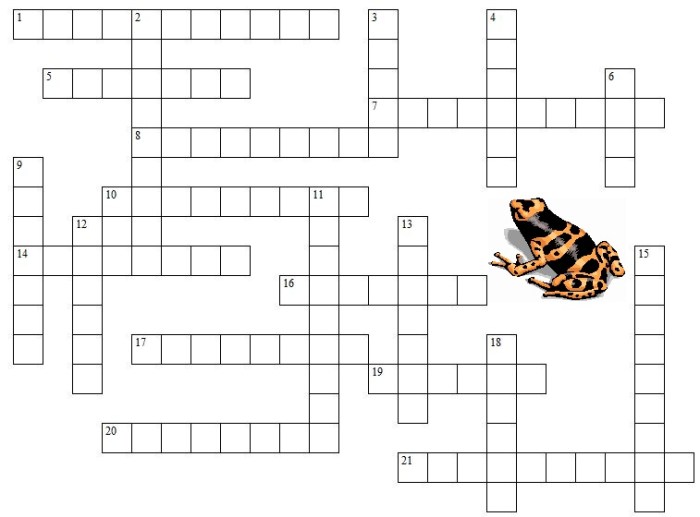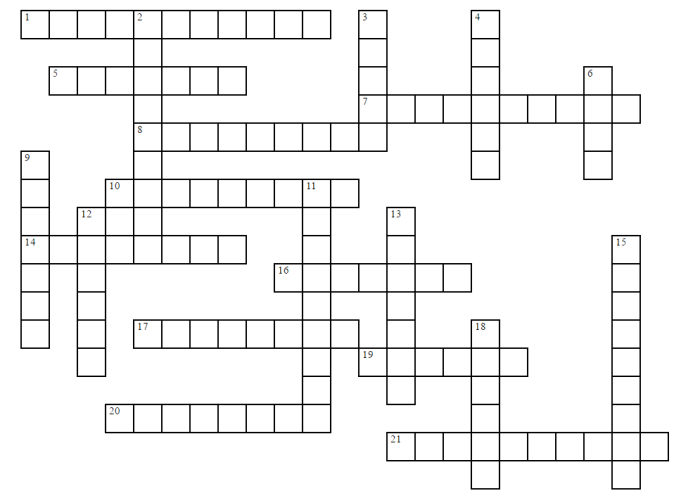Unveiling the mysteries of frog anatomy, the frog dissection crossword answer key provides a comprehensive solution to enhance your understanding of this scientific exploration. Embark on a journey of discovery, where the intricate details of a frog’s anatomy are unraveled, empowering you with a deeper appreciation for the complexities of life.
Within this guide, you will encounter a meticulously crafted glossary of anatomical terms, a step-by-step dissection procedure, and an in-depth examination of the frog’s external and internal anatomy. Delve into the intricacies of the muscular, circulatory, respiratory, and nervous systems, gaining a comprehensive understanding of how these systems work together to sustain life.
Frog Dissection Terminology
Frog dissection involves the study of the internal and external structures of a frog. To accurately describe these structures, specific anatomical terms are used. These terms provide a standardized vocabulary for dissectors, allowing for clear communication and understanding.
Glossary of Terms, Frog dissection crossword answer key
- Anterior:Towards the front of the body.
- Dorsal:Relating to the back of the body.
- Lateral:Relating to the sides of the body.
- Medial:Relating to the middle of the body.
- Posterior:Towards the back of the body.
- Ventral:Relating to the belly or underside of the body.
- Cephalic:Relating to the head.
- Caudal:Relating to the tail.
- Proximal:Closer to the point of attachment.
- Distal:Further from the point of attachment.
Frog Dissection Procedure

Frog dissection is a valuable educational tool that allows students to explore the anatomy of a vertebrate animal. The procedure involves carefully dissecting a preserved frog to examine its internal and external structures.
Step-by-Step Guide
- Obtain a preserved frog specimen.Ensure it is properly preserved and free from any damage.
- Place the frog on a dissecting tray.Use pins to secure it in place, ensuring its ventral side is facing upwards.
- Make a ventral incision.Using a scalpel, carefully make a midline incision from the pelvic girdle to the chin.
- Reflect the skin.Gently use forceps to peel back the skin, exposing the underlying muscles.
- Examine the external anatomy.Identify and label the external structures, such as the head, limbs, and digestive system.
- Remove the internal organs.Carefully remove the organs, such as the heart, lungs, and liver, and place them in a petri dish for further examination.
- Study the internal anatomy.Examine the internal organs, noting their location, shape, and function.
Frog Dissection External Anatomy
The external anatomy of a frog provides insights into its adaptation to its environment. By identifying and understanding these structures, we can appreciate the complexity and diversity of the animal kingdom.
Diagram of External Anatomy
[Diagram of a frog’s external anatomy with labeled structures]
- Head:Contains sensory organs, brain, and mouth.
- Forelimbs:Used for grasping and locomotion.
- Hindlimbs:Used for jumping and swimming.
- Dorsal surface:Dark and moist, provides camouflage.
- Ventral surface:Lighter in color, contains digestive and reproductive organs.
- Cloaca:Common opening for digestive, urinary, and reproductive systems.
Frog Dissection Internal Anatomy
The internal anatomy of a frog reveals the intricate organization of its body systems. By dissecting and examining these organs, we gain a deeper understanding of the frog’s physiology and adaptations.
Table of Internal Organs
| Organ | Function | Location |
|---|---|---|
| Heart | Pumps blood throughout the body | Thoracic cavity |
| Lungs | Gas exchange | Thoracic cavity |
| Liver | Produces bile and detoxifies blood | Abdominal cavity |
| Stomach | Digests food | Abdominal cavity |
| Intestines | Absorbs nutrients from food | Abdominal cavity |
| Kidneys | Filters waste products from blood | Abdominal cavity |
Frog Dissection Muscular System
The muscular system of a frog is essential for movement, posture, and respiration. Understanding the different muscles and their functions provides insights into the frog’s locomotion and behavior.
Table of Muscles
| Muscle | Function | Attachments |
|---|---|---|
| Gastrocnemius | Extends the ankle joint | Femur to Achilles tendon |
| Rectus abdominis | Flexes the body | Pelvic girdle to sternum |
| Biceps femoris | Flexes the knee joint | Femur to tibia |
| Triceps brachii | Extends the elbow joint | Humerus to ulna and radius |
| Pectoralis major | Draws the arm forward | Sternum to humerus |
Frog Dissection Circulatory System

The circulatory system of a frog transports oxygen, nutrients, and waste products throughout the body. By examining the heart, blood vessels, and blood, we can gain insights into the frog’s cardiovascular function.
Diagram of Circulatory System
[Diagram of a frog’s circulatory system with labeled structures]
- Heart:Pumps blood through the body.
- Arteries:Carry oxygenated blood away from the heart.
- Veins:Carry deoxygenated blood back to the heart.
- Capillaries:Tiny blood vessels where gas exchange occurs.
Frog Dissection Respiratory System
The respiratory system of a frog allows it to exchange oxygen and carbon dioxide with its environment. By examining the lungs, gills, and skin, we can understand how frogs breathe and adapt to different habitats.
Components of Respiratory System
- Lungs:Sac-like structures where gas exchange occurs.
- Gills:External structures used for gas exchange in tadpoles and some adult frogs.
- Skin:Moist and permeable, allows for cutaneous respiration.
Frog Dissection Nervous System: Frog Dissection Crossword Answer Key

The nervous system of a frog controls its behavior, senses, and responses to stimuli. By examining the brain, spinal cord, and nerves, we can gain insights into the frog’s neural organization.
Table of Brain Regions
| Brain Region | Function | Associated Nerves |
|---|---|---|
| Cerebrum | Higher-order functions, such as learning and memory | Olfactory, optic, trigeminal |
| Cerebellum | Coordination and balance | Vestibulocochlear |
| Medulla oblongata | Vital functions, such as breathing and heart rate | Vagus, glossopharyngeal, hypoglossal |
| Spinal cord | Transmits signals between the brain and the body | Spinal nerves |
Question Bank
What is the purpose of a frog dissection crossword answer key?
A frog dissection crossword answer key provides solutions to a crossword puzzle that tests your knowledge of frog anatomy, helping you reinforce your understanding of the subject.
What topics are typically covered in a frog dissection crossword answer key?
Frog dissection crossword answer keys typically cover external and internal anatomy, as well as the muscular, circulatory, respiratory, and nervous systems of a frog.
How can I use a frog dissection crossword answer key effectively?
To effectively use a frog dissection crossword answer key, first attempt the crossword puzzle on your own. Then, refer to the answer key to check your answers and identify areas where you need further study.